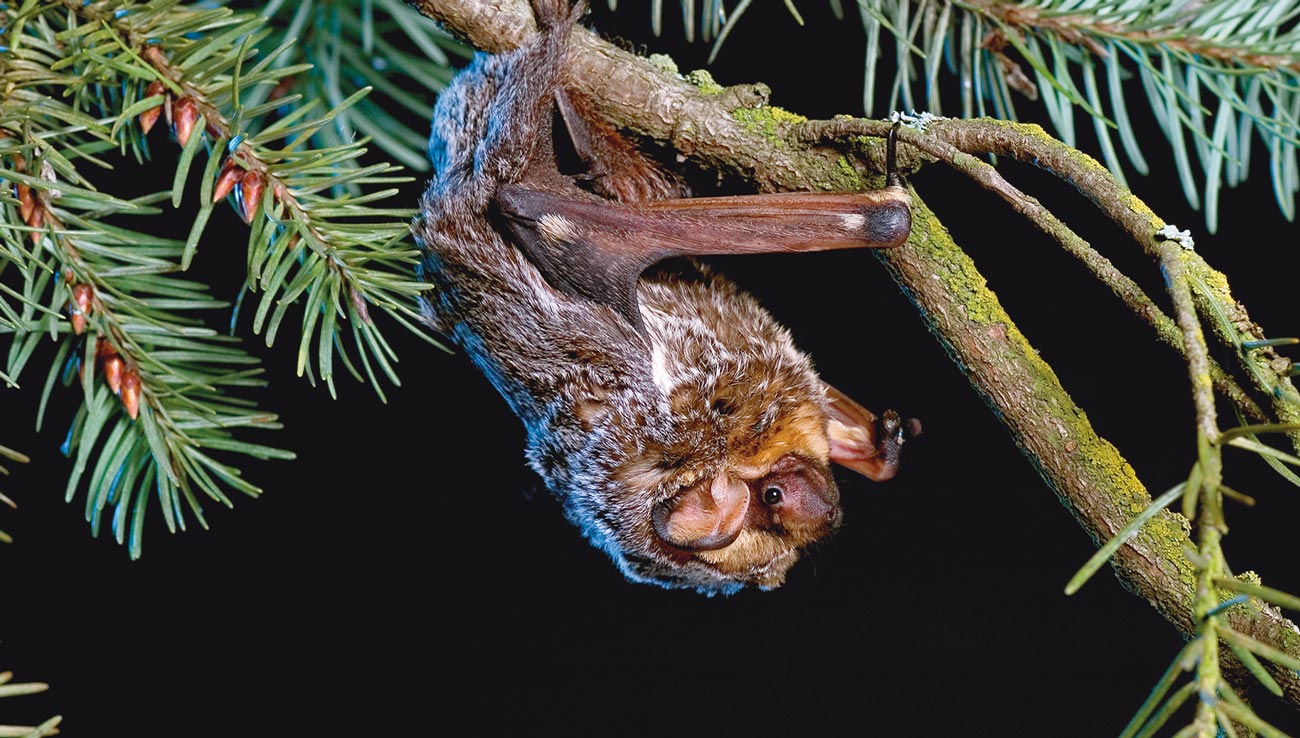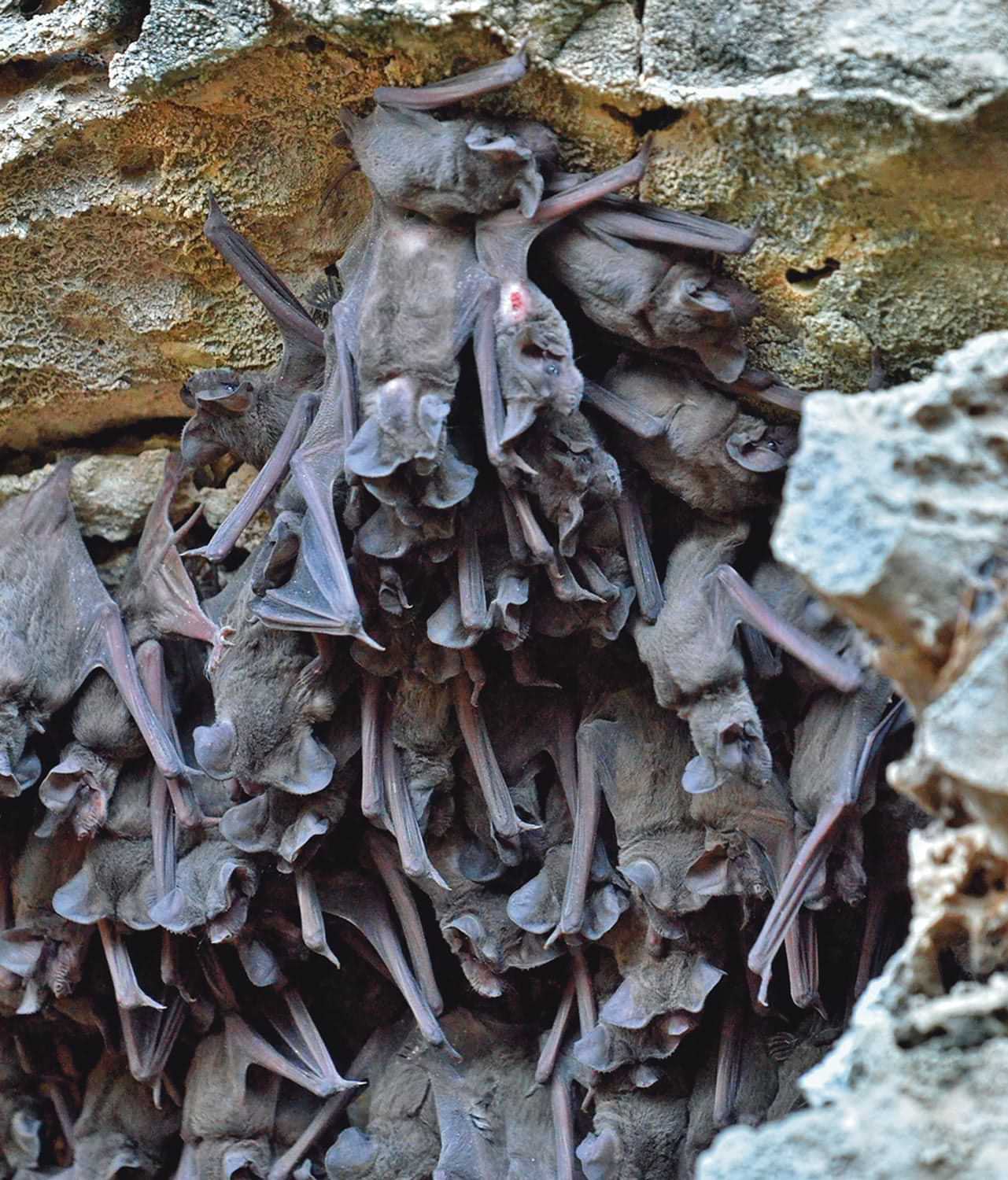State of the Bats Report

More than half of all North American bat species face severe risks over the next 15 years
By Lynn Davis
Cross-border collaboration: North
The hoary bat (Lasiurus cinereus) knows no boundaries or borders. Still, it is one of 82 bat species—more than half of the 154 bat species on the North American continent—at risk for severe population declines over the next 15 years, according to the first-ever North American State of the Bats Report.
The report, a monumental tri-national survey generated by the North American Bat Conservation Alliance (NABCA), compiles research from 102 bat experts across Canada, the United States, and Mexico to establish a baseline of data to measure the success of bat conservation and encourage collaboration. Moreover, it presents a united message that bats need help now to avoid catastrophic conditions later.
The hoary bat is one of 154 reasons the report was compiled and a good example of the complex challenges of bat conservation between three countries, according to Dr. Jordie Segers, Canadian National Bat Health Program Coordinator for the Canadian Wildlife Health Cooperative. It’s important to note that some bat species face different challenges in different locations.

Hoary bat (Lasiurus cinereus)
—Dr. Amanda Adams
“Hoary bats are one of several migratory bat species that cross international borders between Canada, the U.S., and Mexico. In all countries, we’re seeing this species, along with eastern red bats and silver-haired bats, fatally impacted by the rotating blades of wind energy turbines,” says Dr. Segers.
“The State of the Bats Report identifies rapid growth in the wind energy sector on both sides of the border and unites us in identifying this as a threat to find solutions,” he says. “Wind energy is important as a renewable energy source and can, when managed appropriately, coexist with bats. It’s why cross-border collaboration and research is essential to protect these bat species from harm.”
International Collaboration
Three nations come together for North American bats
The State of Bats Report was published by the North American Bat Conservation Alliance (NABCA), a coalition including the United States, Canada, and Mexico. BCI contributed extensive research and provided dedicated staff. A scientific paper documenting data and research collection will be published soon. Additional partners include the Canadian Wildlife Service, Environment and Climate Change Canada, the National Autonomous University of Mexico, and the North American Bat Monitoring Program.


Lesser long-nosed bats (Leptonycteris yerbabuenae)
Cross-border collaboration: South
“The Mexican free-tailed bat (Tadarida brasiliensis) is a species that highlights the importance of reciprocal collaboration between Mexico and the U.S.,” says Dr. Rodrigo Medellin, Senior Professor of Ecology at National Autonomous University of Mexico and co-chair of NABCA.
Dr. Medellin says that free-tailed bats are vital to U.S. and Mexican agriculture crops such as corn, cotton, rice, beans, chiles, and others since they devour and control insect pests.
“The services that this migratory species provides to the U.S. depends on the conservation of overwintering colonies in Mexico,” Dr. Medellin says. “Likewise, the benefits the bats provide in Mexico depend on the conservation of their breeding colonies in the U.S. during summer months. The species would be doomed if both countries did not join forces to secure its future across North America.”
Dr. Medellin also points to the collaborative success in recovering lesser long-nosed bats (Leptonycteris yerbabuenae) as a case study in collaboration. He recounts traveling in the mid-’80s through central and northern Mexico with Dr. Don Wilson from the Smithsonian Institution to known roosts of the lesser long-nosed bat and being shocked to find empty and near-empty roosts. That trip motivated the group, he says, to propose listing this species under the provisions of the U.S. Endangered Species Act in 1988 and the Mexican Federal List of Endangered Species in 1994.
“The major threat was vandalism of roosts, so we started a strong environmental education campaign that changed the attitudes of many people, primarily landowners near the main roosts of the species. This ultimately led to the recovery and delisting of the species in 2013 in Mexico and 2018 in the U.S.,” Medellin says. “The most important part of the State of Bats Report is that it represents collaboration.”
Vast terrain and timing

Photo: Jason Sullivan
“Our goal was to create a baseline for future Status and Trends Reports created with data contributed to the North American Bat Monitoring Program (NABat),” says Dr. Adams. “Technological advances, willingness to form partnerships across borders, and the dire need to document the decline of bats on this continent allow us to move into a new age of bat conservation.”
For example, Dr. Adams points to how acoustic monitoring has advanced bat research and the ability to share research.
“Fifteen years ago, the ability to record and analyze bat calls was expensive and cumbersome. Then, I might go into the field with one detector and worry about having enough digital storage to record one night of calls,” she says. “Today, we don’t have those constraints. Monitoring has become ubiquitous. We now have millions of recordings from across the country that can be used to inform us of the status of bat populations. The true power of this data to information conservation comes through the vast collaboration of agencies and people contributing this data to the NABat monitoring program.”
Putting a face to bats
Report highlights species diversity

Spotted bat
Photo: Bruce D. Taubert
The State of the Bats Report highlights the diversity of North America’s 154 bat species by strategically presenting winsome photos of bats from varying geographic regions. Examples include the spotted bat (Euderma maculatum), with its large ears, found in western cliff formations, and the high- and fast-flying Mexican free-tailed bat (Tadarida brasiliensis), which generally roosts in large colonies under bridges and inside caves like Bracken Cave in the Hill Country of Texas.

Florida bonneted bat
Photo: Dr. Melquisedec Gamba-Rios
“It is important to put a face to the bats we advocate for,” says Dr. Amanda Adams, BCI’s Director of Research Coordination. “We want everyone to recognize the benefits bats provide to healthy environments, the uniqueness of each species, and encourage them to get involved in bat conservation.”
Building a rallying cry
Climate changes—severe droughts that dry up water sources, wildfires that damage habitats, and wide-ranging temperature extremes that disrupt mating and migration—are among the major threats identified in the report. Some of the other threats include land management decisions that degrade or destroy roosts and foraging areas; mortality caused by unmanaged wind turbines; and white-nose syndrome, a deadly fungal disease that has already decimated more than 90% of three hibernating bat species found in the U.S. and Canada.
The challenge is reaching more people with this information to advocate for bats. One of the most significant goals of the State of Bats Report is to get more people engaged in bat conservation, according to Dr. Adams.
Building a rallying cry
Climate changes—severe droughts that dry up water sources, wildfires that damage habitats, and wide-ranging temperature extremes that disrupt mating and migration—are among the major threats identified in the report. Some of the other threats include land management decisions that degrade or destroy roosts and foraging areas; mortality caused by unmanaged wind turbines; and white-nose syndrome, a deadly fungal disease that has already decimated more than 90% of three hibernating bat species found in the U.S. and Canada.
The challenge is reaching more people with this information to advocate for bats. One of the most significant goals of the State of Bats Report is to get more people engaged in bat conservation, according to Dr. Adams.
Putting a face to bats
Report highlights species diversity

Spotted bat
Photo: Bruce D. Taubert
The State of the Bats Report highlights the diversity of North America’s 154 bat species by strategically presenting winsome photos of bats from varying geographic regions. Examples include the spotted bat (Euderma maculatum), with its large ears, found in western cliff formations, and the high- and fast-flying Mexican free-tailed bat (Tadarida brasiliensis), which generally roosts in large colonies under bridges and inside caves like Bracken Cave in the Hill Country of Texas.

Florida bonneted bat
Photo: Dr. Melquisedec Gamba-Rios
“It is important to put a face to the bats we advocate for,” says Dr. Amanda Adams, BCI’s Director of Research Coordination. “We want everyone to recognize the benefits bats provide to healthy environments, the uniqueness of each species, and encourage them to get involved in bat conservation.”
Looking ahead
“As the scope and severity of these threats increase, so does the risk of losing some species forever,” says Dr. Winifred Frick, BCI’s Chief Scientist. “Conservation projects can make the difference between life or death for bats. People working together, from government agencies to bat enthusiasts, are important players to ensure bats have the attention and protections they need to survive and prosper.”
“The message of the report comes down to this: We need bats, and bats need us. It’s a phrase my 13-year-old son came up with. Getting kids involved and galvanizing our community to participate in bat conservation is our path forward to help bats and help ourselves,” Dr. Frick says.